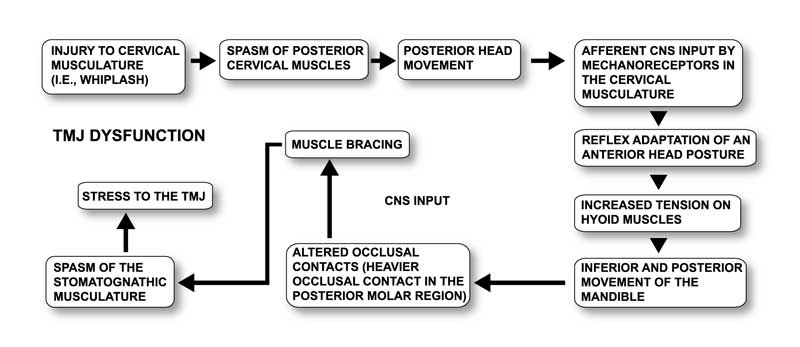Cervical Myospasms and TMJ Treatment in San Diego
Cervical Myospasms as an Etiological Factor in the Development of Temporomandibular Joint Dysfunction
By Dr. George Georgaklis. Originally published in San Diego Chiropractic Journal.
 When presented with the task of identifying the etiological factors responsible for the development of a TMJ disorder or myofascial pain, the primary goal of the practitioner has traditionally focused on identifying an abnormality or discrepancy in the functioning of the occlusal system. Little or no attention has usually been directed at identifying patterns of abnormal muscle function in the neck, in spite of the fact that abnormal cervical muscle functions are known to contribute to, or actually cause a temporomandibular joint dysfunction or myofascial pain syndrome.
When presented with the task of identifying the etiological factors responsible for the development of a TMJ disorder or myofascial pain, the primary goal of the practitioner has traditionally focused on identifying an abnormality or discrepancy in the functioning of the occlusal system. Little or no attention has usually been directed at identifying patterns of abnormal muscle function in the neck, in spite of the fact that abnormal cervical muscle functions are known to contribute to, or actually cause a temporomandibular joint dysfunction or myofascial pain syndrome.
While all patients with cervical myopathy do not exhibit temporomandibular joint or myofascial pain dysfunction syndromes, it is essential for the practitioner to appreciate the fact that the potential for the development of such dysfunctions in these patients is always greater than in those patients with normal cervical muscle function.
The following diagrammatic outline will illustrate the manner by which spasm in the cervical musculature can directly cause a pathological occlusal relationship, which can in turn cause the development of a TMJ disorder or myofascial pain dysfunction syndrome.
Mechanoreceptors located in the upper cervical spine and the mandible are extremely sensitive to even slight changes in the normal posture of the head, neck and mandible. By sensing, and reflexively correcting deviations from the normal postural relationships in these structures, the mechanoreceptors serve to maintain a physiologically stable relationship of the cranium to the spine.
Dysfunctions of the cervical musculature can result in the presence of both local and referred musculoskeletal symptoms.
LOCAL SYMPTOMS OF CERVICAL MUSCLE SPASM
1. Decreased range of motion
2. Muscle Stiffness and/or tightness
3. Pharyngeal pain and/or tightness
4. Abnormal swallowing patterns (from a loss of normal cervical curvature)REFERRED SYMPTOMS OF CERVICAL MUSCLE SPASM
1. Pain in the arm and hand (resulting from nerve irritation, compression, or entrapment in the region of D4 to C7)
2. Pain in the supraorbital region and the angle of the mandible (resulting from nerve irritation, compression, entrapment from C1 to C3)
Cervical Myospasms and TMJ Treatment in San Diego | Make an Appointment Today
Contact our San Diego TMJ Treatment Center, conveniently located at University Town Center in La Jolla. Call (858) 552-1223 to schedule your consultation with Dr. George today. Stay connected, like us on Facebook!
